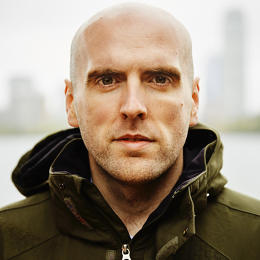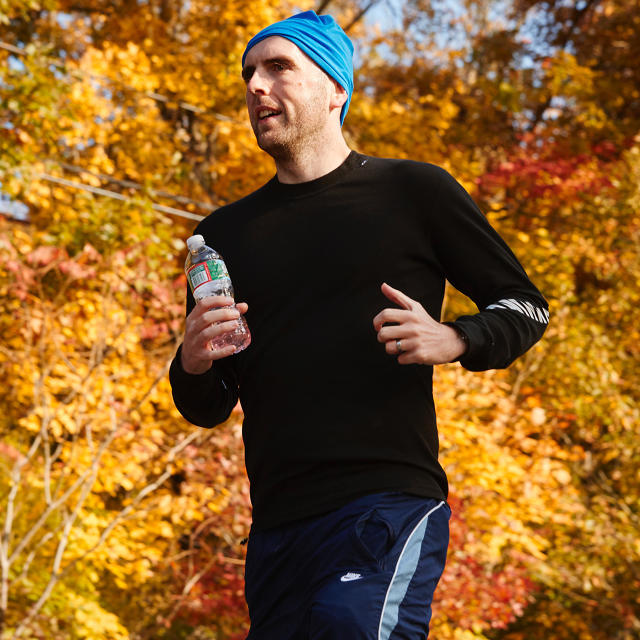How One Blind Marathon Runner Is Using Technology To Run Solo
Of the 27,487 runners who traversed the city of Boston this year for the marathon, 39 were visually impaired.
Running a marathon blind can be terrifying: Hordes of runners are bolting toward you, crowds scream from the sidelines, and you have no idea if you’re about to crash into someone ahead of you. But for 31-year-old Simon Wheatcroft, a blind Englishman who completed the marathon on Monday, there is nothing more exhilarating.
“I want to take it all in,” he tells Fast Company. “I want to enjoy the sounds of the other runners and the people cheering.”

Marathon organizers pair blind runners with guides who run at the same pace, sometimes even connected by a rope. While Wheatcroft ran with two guides on Monday, eventually he would like to be able to run a marathon independently.
“The idea of running solo has always been in the back of my mind,” he says. “I’ve been dreaming about it for four years. It took me some time to become mentally comfortable with the concept. “
He believes that technology is the key to making this happen. He points out that there are already many different tools on the market—like sophisticated GPS navigation and motion sensors—that could help visually impaired runners. It’s just a matter of putting them together into a customized tool.
Over the last month, Wheatcroft has been collaborating with IBM to develop an iPhone app allowing him to navigate a marathon course without help. He tested it out for the first time at Monday’s marathon. Little signals alerted him whenever he veered too far to the right or left, so he didn’t worry about going off course.
“I could enjoy the race. I could listen to the crowd,” Wheatcroft says. “The app only alerted me if I went wrong. The rest of the time, it was completely silent.”
Running Blind
At the age of 13, Wheatcroft discovered he had a degenerative eye disease and by 17, he had lost his vision completely.
Before he tried running, he tried climbing. He had the romantic notion of asking his girlfriend to marry him from the top of a mountain in California. But as he began the journey, he realized the ascent would be far more difficult than he had anticipated. There were too many dangerous cliffs and crevices to circumvent; too many ways to get hurt. In the end, he was forced to propose halfway up the mountain, and although she said yes, he still felt defeated.
“It was just too hard,” Wheatcroft says. “But then I had to live with the fact that I had to quit climbing. It plagued me.”
When the couple returned to England, Wheatcroft decided he would never again abandon a challenge because of his blindness. Running seemed insurmountably difficult to him at the time. But while many blind people avoid running altogether because it is just too complicated, Wheatcroft was determined not only to become a runner, but to run on his own, without having to depend on a guide.
“When I started, I ran into lampposts and traffic lights and trees,” he recalls. When you’re charging forward at a high velocity, anything you crash into can cause pain. Cars may not see you in time to stop. Dog walkers and parents with strollers are unable to get out of the way quickly enough. Early on, he remembers feeling an occasional rush of horror that something might happen to him.
“The biggest challenge is mental: You can’t be fearful,” Wheatcroft says. “You have to just absolutely convince yourself that this is possible.”
Wheatcroft initially kept to safe spaces, like the distance between goal posts on a football pitch, but he eventually got bored of this. When he ran on the street, he discovered that people don’t generally get out of the way, expecting runners to dodge them. So contrary to widely accepted notions of safe running, he decided to run on the side of the freeway, where there is a wide berth away from the cars and no human traffic.
Over the last six years, Wheatcroft has evolved into a serious long-distance runner. In 2014, he ran from Boston to New York, then completed the New York Marathon, covering a total of 240 miles in nine days. On May 1, he will begin a seven-day run in the Namibian desert for a 160-mile ultra-marathon.
Technology Solutions
There are currently no apps specifically designed for the blind running community. When Wheatcroft began running in 2010, he relied on apps designed for sighted runners. He started using Runkeeper several years ago, which allows him to map out a route, track his speed, and receive audio signals that inform him when he needs to turn left or right. When Google Glass came out, he immediately saw its potential for blind runners. But none of these technologies are perfectly suited to his needs.
Wheatcroft is determined to create his own app. While training for the Boston Marathon, Wheatcroft began searching for a technology partner to help him on his quest. He decided to reach out to IBM, knowing that the Runkeeper app runs on the IBM Cloud. IBM invited him to London to visit the Bluemix Garage, its developer space, where he pitched the engineers there an idea for an app for visually impaired runners. IBM quickly came on board, agreeing to create an app for him pro bono.
As Wheatcroft describes his ideal app, he points out that he doesn’t want the navigation to be too noisy. The GPS systems he’s used so far have had elaborate directions communicated in complete sentences; he’d prefer a series of little sounds.
“We thought subtle beeps were far more immediate than hearing ‘left’ and ‘right’,” he says. “I don’t want to be taken out of the social experience of the race.”
Wheatcroft also says that the GPS systems built into most consumer devices are only accurate to 10 or 20 meters. “When you’re running on an edge of a cliff, a difference of 10 meters is an issue,” he points out. IBM has outfitted this new app with a more advanced external GPS receiver that gives directions that are accurate to five meters.
Wheatcroft piloted a version of the app at the Boston Marathon on Monday. It was a good testing ground because the course is fairly simple with only two turns. The app allowed him to focus on the race and gave him confidence that he was on the right path. To gather even more feedback about the app, he will bring it with him to Namibia at the end of the month for a seven-day run in the desert, which will be rather more treacherous and require the device to have an extended battery life.
“This is very much an iterative process,” Wheatcroft explains, describing how he’s tweaked the various audio feedback mechanisms to make them clearer. “We wanted to create a minimum viable product in a week and then continue making changes as I take it on the road with me. We test one thing at a time.”

While the app Wheatcroft has built with IBM is an improvement on the generic running apps on the market, he believes there is a lot more it should be able to do. He wants the app to be able to explain what objects are directly in front of him and provide dynamic directions that respond to the immediate environment. This would require the app to be able to scan his surroundings and then have an artificial intelligence system, such as Watson, that would determine the best course. He’d also like to create a belt that will vibrate so that he won’t need to depend on the beeps from the phone. He’s currently working with developers at IBM to find ways of achieving these goals.
He’s also very keen on Google’s Project Tango, a technology that will give mobile devices spatial vision using sensors, motion tracking, depth perception, and image processing. Google is currently selling developer kits so that it can be tailored to a range of purposes, like helping customers navigate through a store. But Wheatcroft believes that it could be game-changing for blind runners.
Ultimately, he’s hoping to create an app that will be widely and inexpensively available to the entire blind community. While IBM holds the intellectual property surrounding this technology, a company spokesperson says it has no plans to monetize the app because it is such a specialized use case.
“It’s more of an exercise in exploring the limits of human computer interaction,” the spokesperson explains.
Meanwhile, Wheatcroft is very excited about the possibility of putting out an app that will work on any iPhone.
“I don’t particularly like using any device that is specifically made for the visually impaired because it’s usually super expensive and super clunky,” he says. While Wheatcroft is testing the technology on his runs, a user doesn’t have to be a runner to see a benefit from this app.
“We’re creating a core technology that allows you to navigate using beeps and haptic, which can then be applied so broadly to lots of situations,” Wheatcroft says. That means whether you’re running marathons in Namibia or just finding your way around a store, Wheatcroft’s app could vastly improve life for blind people everywhere.
(42)





